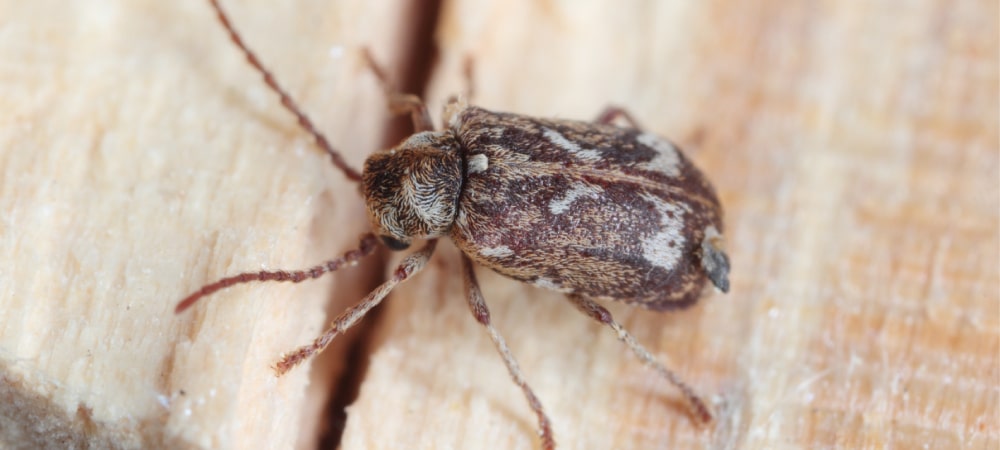
Key Facts About Deathwatch Beetles (Xestobium rufovillosum)
May 22, 2023
By Daniel Baldwin, BCE, CCFS, CP-FS
Ailing trees and weakened wood on your property could be signs of deathwatch beetle damage, as these pests are common in some parts of the U.S. Read on to get the facts on these wood-destroying beetles and for tips on getting rid of deathwatch beetles.
What is a deathwatch beetle?
A deathwatch beetle (also called a woodworm) is a beetle from the Anobiidae family. These insects lay their eggs in softwood. When deathwatch beetle larvae hatch, they burrow deeper into the wood, causing damage while consuming the cellulose in trees or wood structures. Then, they enter the pupa stage and emerge as full-grown adults. At this point, deathwatch beetles make exit holes in the wood and go out looking for mates to restart the life cycle. This entire process takes about two years.
What do deathwatch beetles look like?
The average deathwatch beetle size is around 0.1 to 0.2 inches in length, and depending on their species, they may be reddish-brown or black. Usually, their bodies are mottled with lighter, irregular spotting. The males of many species have long antennae that resemble deer antlers, while females typically have shorter antennae.
Deathwatch beetle larvae have plump, wrinkled bodies. Their front legs are pronounced, but their back legs are difficult to see. Typically, larvae are light yellowish-brown and have noticeable hairs protruding from their heads and bodies.
What sound do deathwatch beetles make?
You may find it easier to recognize the deathwatch beetle sound than to identify the pests by sight. The adult deathwatch beetle makes a distinctive clicking sound by tapping their head against the wood. This deathwatch beetle noise is a form of communication, and it can be very audible if you have a large deathwatch beetle infestation. You’ll likely notice the sound when the beetles are most active at night.
Why are they called deathwatch beetles?
The name deathwatch beetles makes the pests seem ominous, but they don’t pose a risk to human health. Historians believe the name comes from the Middle Ages when people thought the beetles’ tapping sound was the grim reaper tapping his scythe as he sought out souls to claim. Yikes! Beetles in your walls seems less dire compared to that, at least.
Where does the deathwatch beetle live?
The deathwatch beetle is most common in coastal areas of the U.S. and is also in some parts of Europe. Generally, the pests prefer to lay their eggs in trees already damaged by disease or moisture because the wood is softer and easy to tunnel into.
Although they prefer trees, deathwatch beetles may also live in wood piles and wooden outdoor structures. They may make their homes in unfinished wood furniture, but generally can’t tunnel into wood that has been painted or treated.
Occasionally, deathwatch beetles may accidentally get transported into interior spaces by crawling through cracks or being carried inside on firewood. However, the beetles typically don’t infest furniture and wooden items indoors.
How do I know if I have deathwatch beetles?
The clicking sound the insects use to talk to one another is one of the most obvious death watch beetle infestation signs. You may also notice small, round holes around one-sixth of an inch in diameter from where the adult beetles came out of the wood. Occasionally, you may see a dark-colored loose powdery sawdust material called frass in the area. This material is a mix of wood waste and excretions from the beetles. Normally, this material is densely packed into the wood, but in some cases, the larvae push it out as they tunnel into the wood.
How do I get rid of deathwatch beetles?
The best way to get rid of deathwatch beetles is to enlist the services of a professional pest control company. Licensed pest control technicians can identify trees and structures affected by the pests and develop a plan for treating deathwatch beetles.
You can take steps to reduce the risk of infestations around your home by:
- Keeping firewood protected with pest-proof covers or storing it inside an outbuilding
- Removing dead and diseased trees from your property
- Eliminating fallen trees and stumps
- Treating and sealing wooden structures like decks and sheds and wooden patio furniture
- Replacing moisture-damaged wood in outdoor structures
Categories
RELATED POSTS



